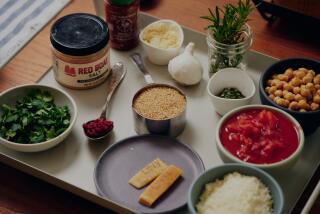Miso in America: The Toast Variation
- Share via
My 16-year-old son thinks his American breakfast is not complete without miso soup. He dips his toast in the soup, which is something I have never seen a Japanese do, but he says it’s delicious.
My own mother never made miso soup for breakfast even though it is part of a traditional breakfast in Japan. She spent her girlhood in wartime Japan, dreaming of someday owning a big GE refrigerator stocked with butter and cream. So when she moved to America with my father and their five children, breakfast often consisted of steamed rice with melted butter on top and tall glasses of whole milk.
In the ‘70s, my mother got nostalgic for Japanese foods, especially miso. One day, she bought a bag of dried soybeans, soaked the beans overnight, cooked them and blended them to make a mushy white paste. She added salt and koji, a miso starter made from fermented rice, and created a huge mess in the kitchen.
The resulting miso was kept it in a lidded clay jar in the cool and dark corner of the garage for years. We used to sneak in there and stick in fingers to lick the thick, grainy paste that looked like mud. Later, when I was much older, I realized I was snacking on a very healthy food, maybe a bit salty, but still full of protein.
Miso soup’s main ingredient, miso paste, is made mostly from soybeans-”meat from the fields” as the Japanese have called it for centuries. Miso contains high levels of protein and more Vitamin B, Vitamin E, calcium and iron than beef, not to mention that it is low in fat and cholesterol. So it makes an ideal base for a healthy soup.
There are thousands of types of miso, which in Japan enjoys a mystique almost like wine in France. Miso, too, is fermented for at least a year, often as long as three years.
Also like wine, miso paste comes in red and white varieties. Red (aka) miso pastes like sendai and haccho are dark brown in color, and robust in flavor. White (shiro) miso pastes like saikyo are yellow in color, lighter and sweeter than red miso paste.
Some miso pastes such as inaka miso, koji miso and mugi miso incorporate grains of wheat, rice, barley or soybeans to create a variety of textures and tastes.
For me, the ultimate use of miso is in a soup. My mother’s theory of miso soup is to fill the bowl with a variety of vegetables from the land and sea-so full that you can stand a pair of chopsticks in the bowl.
You can experiment with different types of miso pastes. Some are saltier than the others, so when making miso soup, always taste the soup and make adjustments. I have four or five different miso pastes in my fridge at all times. I let my whim dictate which goes into the soup.
Even without toast, miso soup is not for the doctrinaire.
*
Sakai is a freelance writer living in Southern California.
*
Teapot, bowls, teacups, tray and condiment dish from Yuzu, Pasadena.
Miso Soup With Chicken and Vegetables
Active Work and Total Preparation Time: 25 minutes
1 sweet potato or other potato
1 carrot
1 (2-inch) piece daikon radish
1 1/2 tablespoons oil
1/3 pound boneless, skinless chicken, sliced into 1/4-inch cubes
3 1/2 cups Dashi
1 tablespoon red miso
1 1/2 to 2 tablespoons saikyo miso
4 ounces soft tofu, cut into 1/2-inch cubes
1 green onion, chopped
1 (1-inch) piece ginger root, thinly sliced, optional
1 teaspoon ground sesame seeds, optional
Peel the potato, carrot and daikon radish, then slice them about 1/8-inch thick. You might have to quarter the potato and daikon if they are big.
Heat the oil in a nonstick saucepan over medium heat and cook the chicken, potato, daikon and carrot 1 minute. Add the Dashi and cook over high heat until the vegetables are tender but still firm, 3 minutes. Reduce the heat to a simmer.
In a small bowl, dissolve the red miso and 1 1/2 tablespoons saikyo miso with a few tablespoons of the hot Dashi, and add the mixture to the saucepan, along with the tofu. Taste the soup and add more miso paste, Dashi or water, depending on how strong it tastes.
Pour the soup into serving bowls, sprinkle each bowl with the chopped green onion, ginger and sesame seeds and serve at once.
4 servings. Each serving: 167 calories; 434 mg sodium; 16 mg cholesterol; 8 grams fat; 13 grams carbohydrates; 11 grams protein; 1.22 grams fiber.
Miso Soup With Tofu and Enoki Mushrooms
Active Work and Total Preparation Time: 15 minutes
Look for wakame seaweed, called for in the Miso Soup variation, at Japanese markets.
*
3 1/2 cups Dashi
3 1/2 to 4 tablespoons koji or mugi miso
6 ounces soft tofu, drained and cut into 1/2-inch cubes
1/2 (3 1/2-ounce) package enoki mushrooms, ends trimmed off
1 green onion, chopped, optional
Bring the Dashi to a boil in a medium saucepan, then reduce the heat to maintain a simmer.
In a small bowl, dissolve 3 1/2 tablespoons of the miso paste in a few tablespoons of the warm Dashi. Add the mixture to the saucepan. Taste and add more miso paste, Dashi or water, depending on how strong the soup tastes.
Add the tofu and mushrooms to the soup. Bring the soup to a quick boil once again, then remove it from the heat and pour the soup into individual bowls.
Sprinkle each bowl with chopped green onion. Serve immediately.
4 servings. Each serving: 71 calories; 555 mg sodium; 0 cholesterol; 3 grams fat; 6 grams carbohydrates; 5 grams protein; 0.65 gram fiber.
*
Variation: To make one of the most popular miso breakfast soups, Miso Soup With Wakame Seaweed and Tofu, follow this recipe but substitute 1/4 cup rehydrated wakame seaweed, chopped to 1-inch pieces, for the enoki mushrooms.
Dashi
Active Work Time: 5 minutes * Total Preparation Time: 30 minutes
This will keep five days in the refrigerator, so you can make it the night before and just add miso paste and vegetables for quick breakfast of miso soup. You can find bonito flakes and dashi konbu at Japanese markets.
1 piece dashi konbu (6 to 8 inches long)
4 cups water
2 cups dried bonito flakes (katsuo-bushi)
Using scissors, make several crosswise cuts in the konbu. This helps to extract the flavor during cooking.
Place konbu and water in medium saucepan and let it stand 15 minutes. Cook on medium heat until water almost boils. Remove konbu just before water boils to avoid fishy odor.
When the water boils, add bonito flakes and cook over low to medium-low heat for about 30 seconds. Turn off heat. When bonito flakes have settled near the bottom, about 10 minutes, strain them through a very fine-mesh sieve or a sieve lined with cheesecloth and discard them. Don’t stir the stock because it will cloud the dashi, which should have a light golden color.
3 1/2 cups or 4 servings.
Miso Soup With Kabocha Squash and Green Onions
Active Work and Total Preparation Time: 15 minutes
1/4 small kabocha squash, about 1/4 pound
3 1/2 cups Dashi
3 1/2 to 4 tablespoons red or white miso paste
2 green onions, chopped, optional
Seed and peel the squash. Slice it into 1/8-inch thick pieces.
Bring the Dashi to a boil in a medium saucepan, add the squash and cook for 2 minutes over medium heat.
In a small bowl, mix the miso with a few tablespoons of the hot Dashi. Add it to the saucepan. Return the soup to a quick boil, then remove it from the heat and pour the soup into individual bowls. Sprinkle each serving with chopped green onions.
4 servings. Each serving: 42 calories; 552 mg sodium; 0 cholesterol; 1 gram fat; 5 grams carbohydrates; 2 grams protein; 0.54 gram fiber.


